How we organized a photo / video studio in office conditions
Hello to all. I want to talk about how and why we organized a studio for video production in our office. A little bit about yourself. I take a great interest in a photo, I remove reportings and musicians . Recently, I work as a marketing manager in an IT company : photography and video - one of my priorities. I had not worked in marketing and PR before, but from the words of my manager, experience in photography plus extensive work experience in traditional archives and knowledge of digitizing and storing documents played a decisive role in offering me this job.
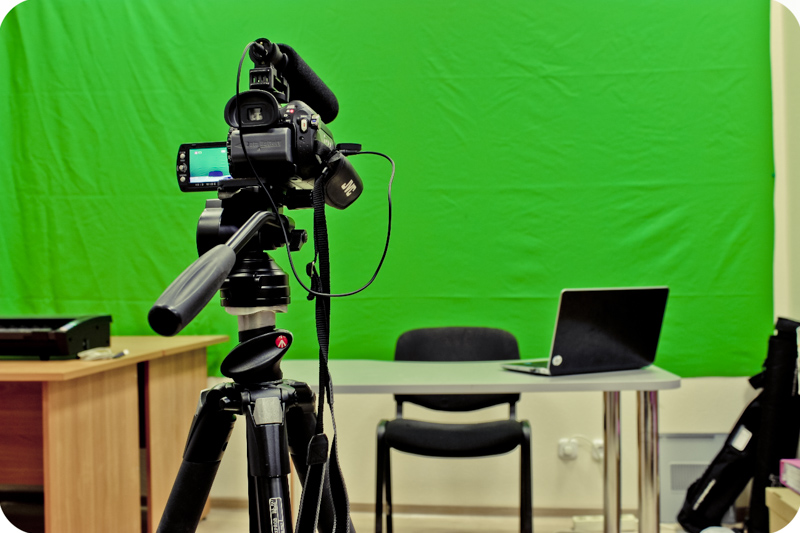
')
More and more companies use video to promote their products and services. Texts of sites, instructions (RTFM), no one reads the technical specifications. The first thing the user is interested in is the video, and if there is none, he goes to the pictures, text, diagrams, etc. In our company, it was decided to shoot their own video within the marketing department. My first proposal and my first task was the organization of a small studio for creating staged videos in the office.
We are engaged in the development of electronic archives and libraries, industrial scanning, sale of book scanners based on SLR cameras, and also recently organized an IT training center. We have a lot of open events (True Tester, MarketoIT) that require shooting. In addition, there is an acute task of shooting an advertising, review and training video on products, services and directions.
To understand what process we need to build, we began to analyze video materials of competitors. Some did everything “expensive”, using the resources of federal channels and major media. The second hired a team of professionals who also filmed a fairly high-quality video. Still others filmed the video “soap box” or a simple camera. The quality of the picture and the methods of shooting the program part (the camera was aimed at the monitor) was stuck at the level of a person who took the video camera for the first time in his life.
If everything is more or less clear from the video of events, then there are many questions with staged questions.
We have defined a number of requirements for the process.
In accordance with our marketing plans, it is necessary to start shooting the following video:
Software products : training, reviews of functions and methods of work, analytics on the ECM / EDS market, etc.,
For book scanners : training in assembly, configuration and operation (including software), equipment reviews and new products on the market,
IT training center : video cards for teachers and reviews of their courses, interviews with students, reports on open events.
The room was selected on the basis of several factors:
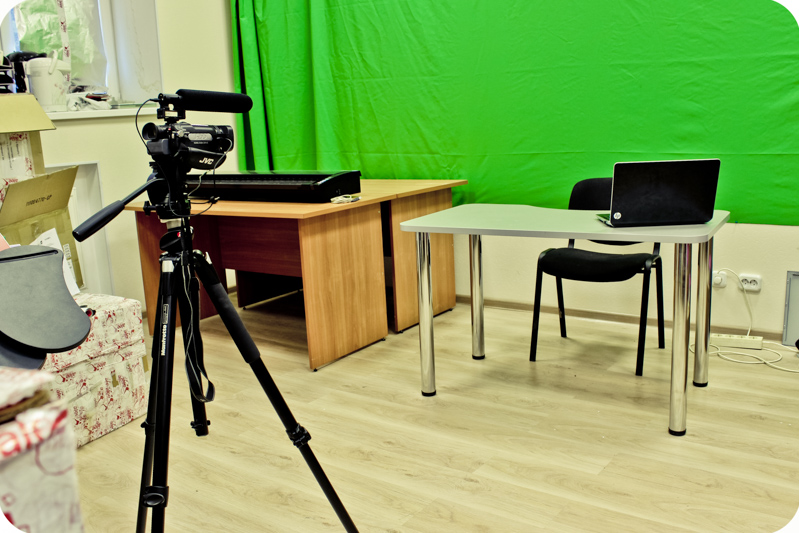
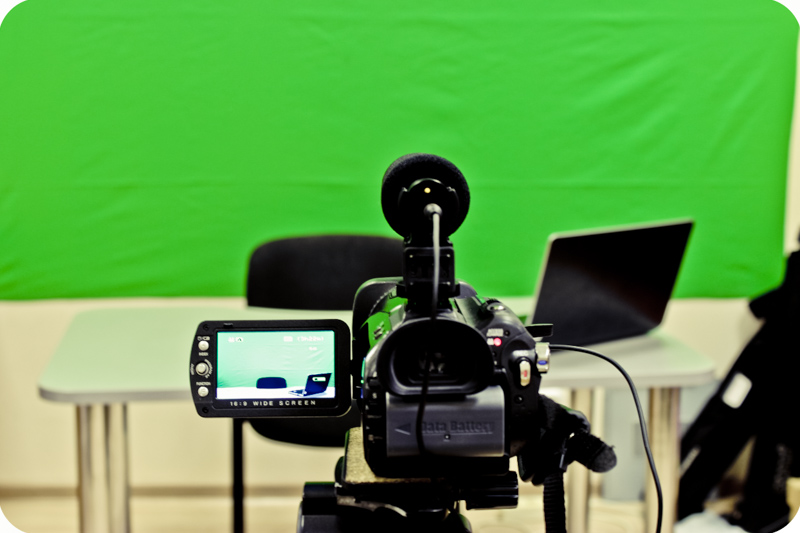
Hence the conclusion: for comfortable shooting, the required size of the room is 5x4 meters. This space will include a table with the assembled scanner, a table for “news” video, space for placing and storing all video equipment necessary for shooting.
Such a room in the company was found - a warehouse .

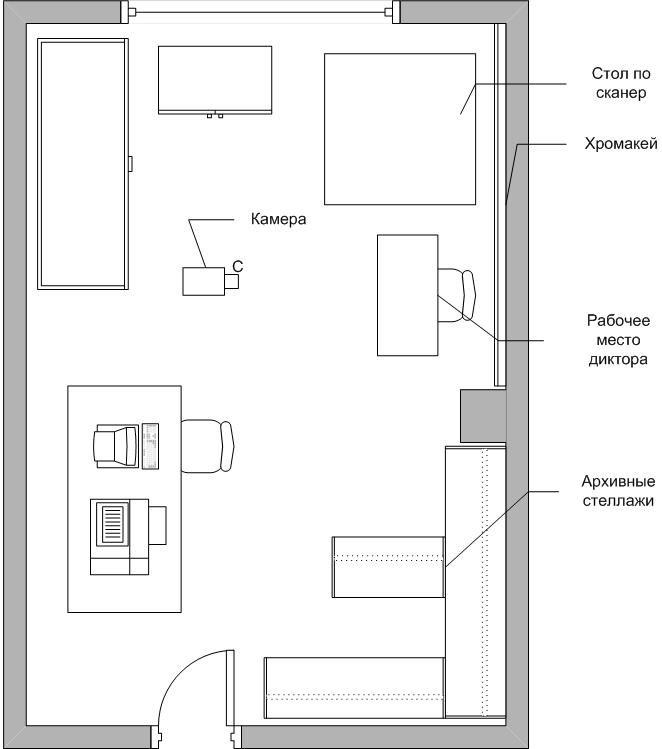
The studio device should be able to shoot video with a flexible choice of backgrounds and storyboards. For this we need:
We had2 sachets of grass 75 ampoules mescaline half of what we needed:

It remains the case for small. We decided to take the background hromakey (this is such a green or blue rag, against which many modern films are being made). Why hromakey? Because it is cheap. One green background is a countless number of backgrounds by simple editing. Installation was made on a clothesline (we recommend a string), which was attached to the wall with dowels.

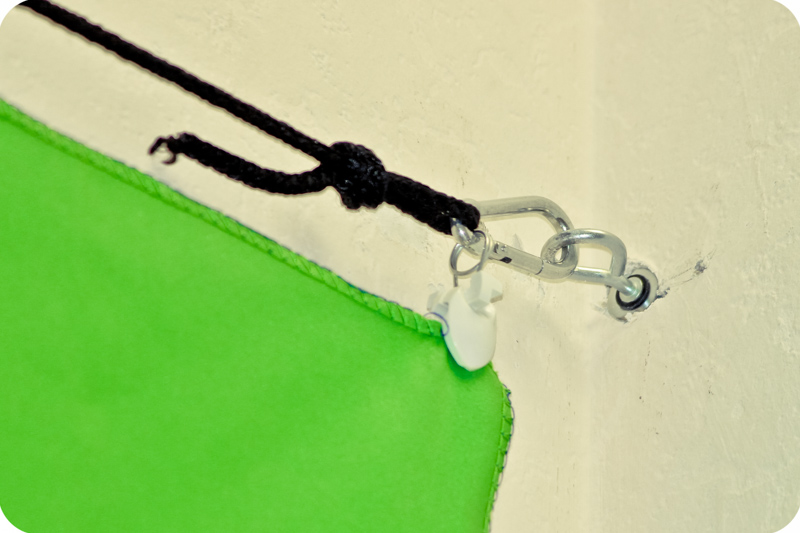
Since the first video turned out pretty good, with the purchase of lighting equipment, we decided to wait for now. However, we did some manipulations. First, they sealed all the windows so as not to interfere with natural light. Secondly, hromakey was slightly lit with table lamps so that there were no hard foreground shadows. The light remained from the fluorescent lamps on the ceiling.
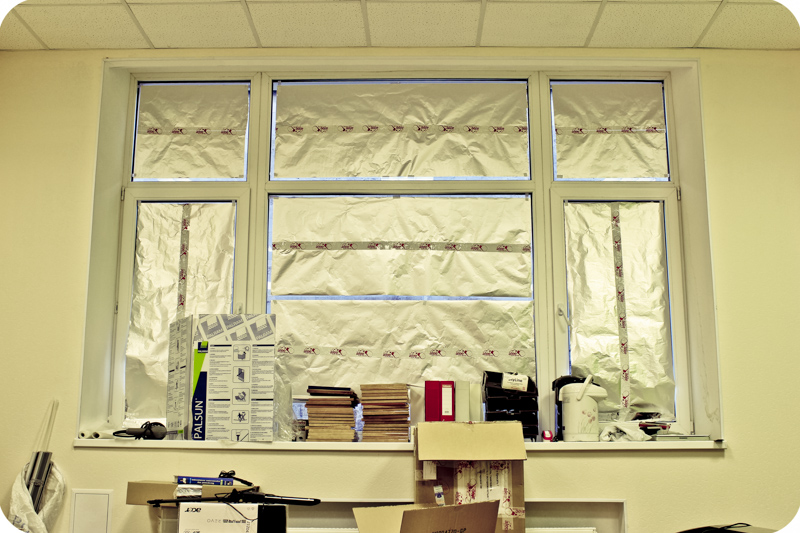
The most expensive item in the purchase of this software. After a short selection, we settled on Adobe Premiere CS6.
The total for the money:
Total: ~ 108000 rubles.
After analyzing the video recording and editing market, I found out the average price for shooting a video - 20,000 rubles. Hence we assume: one-time costs are plus to fixed, i.e. the salaries of the participants and the rental of the premises, we get the amount that must be recaptured afterwards with the video. We do not take full salary, because the shooting process is not the total working time of the participants. Room rental - 900 rub / m2 per 20m2.
108000 + 20000 + 18000 = 148000 rubles
Accordingly, if you shoot 2-3 videos per month, the profit will begin in 3-4 months or 7 videos.
For two months we filmed and mounted:
Total: 8 videos. It turns out, the task of ROI is completed as soon as possible.
A couple of examples of our studio video:
Habraacter revseev
It is clear that the shot video and photos should not go on the shelf, they must be promoted and unwound.
A completely separate task - shooting events. In itself, an IT event is not easy and how to shoot it correctly, in order to get several types of clips (full video of reports, promotional videos, interviews) is a topic for a separate post. If interested, then I will definitely write how we organize such a shooting.
I will be glad to questions. If your company constantly removes the video - let's share the experience.
Upd: Summarize the tips in the comments. Thank you for helping Tmix , Moskus , Mikhail_K , Alexufo , GeForester
For events it is better to get a radio system. I advise you to rely solely on the sennheiser company. To save the radio, you can collect from the transmitter and Sony ems and there you have already thrown at the speaker and that's it - there is a speaker sound (if the event organizers are experienced, the speaker will be with a microphone).
Microphones can be selected on the basis of the budget, although usually cheap Rode, Azden and the like fit into the budget. It is not that. Again, I choose sennheiser, what to do is expensive and of high quality. But here, too, need to look and listen. Dynamic for high-quality sound at “sessions”, narrowly targeted for quick recording of “synchronous”. "Fishing tackle" - just do not like, this is a sorry miscarriage of some kind. Ideally without a built-in cord - it is frayed, rumbles.
To record sound on the street, it is better to buy rycote windshields (for loop and for microphone). (Advice from VK from Alexey Eremenko)

So let's get started
')
More and more companies use video to promote their products and services. Texts of sites, instructions (RTFM), no one reads the technical specifications. The first thing the user is interested in is the video, and if there is none, he goes to the pictures, text, diagrams, etc. In our company, it was decided to shoot their own video within the marketing department. My first proposal and my first task was the organization of a small studio for creating staged videos in the office.
What is it for us?
We are engaged in the development of electronic archives and libraries, industrial scanning, sale of book scanners based on SLR cameras, and also recently organized an IT training center. We have a lot of open events (True Tester, MarketoIT) that require shooting. In addition, there is an acute task of shooting an advertising, review and training video on products, services and directions.
Competitive analysis
To understand what process we need to build, we began to analyze video materials of competitors. Some did everything “expensive”, using the resources of federal channels and major media. The second hired a team of professionals who also filmed a fairly high-quality video. Still others filmed the video “soap box” or a simple camera. The quality of the picture and the methods of shooting the program part (the camera was aimed at the monitor) was stuck at the level of a person who took the video camera for the first time in his life.
Gathering requirements for the video production process
If everything is more or less clear from the video of events, then there are many questions with staged questions.
We have defined a number of requirements for the process.
High-level business requirements
In accordance with our marketing plans, it is necessary to start shooting the following video:
Software products : training, reviews of functions and methods of work, analytics on the ECM / EDS market, etc.,
For book scanners : training in assembly, configuration and operation (including software), equipment reviews and new products on the market,
IT training center : video cards for teachers and reviews of their courses, interviews with students, reports on open events.
Process requirements
- Creating unique content, including script development,
- Formation of the film crew, teamwork plan,
- Shooting, installation, voice,
- Postproduction: computer effects, subtitles, translation, etc.
- Mastering
- Promotion
Room and workspace requirements
The room was selected on the basis of several factors:

- The height of the book scanner in the assembled state on the table exceeds two meters. Given the actor standing next to and telling about the scanner, we get a working area of 3x2 meters. If we want to shoot at medium focal lengths (35-50mm), in order to avoid distortion at the corners of the picture, there should be 2-3 meters between the subject and the camera.

- We also plan to shoot an actor at the table. Here are more benign criteria. This is a working area the size of a table, and the required distance to the camera is about one and a half meters.
- Storage of all equipment used in shooting.
Hence the conclusion: for comfortable shooting, the required size of the room is 5x4 meters. This space will include a table with the assembled scanner, a table for “news” video, space for placing and storing all video equipment necessary for shooting.
Such a room in the company was found - a warehouse .


Equipment requirements
The studio device should be able to shoot video with a flexible choice of backgrounds and storyboards. For this we need:
- Camera
- Tripod
- Microphone / Dictaphone
- Background
- Shine
- Installation equipment
- Installation software
What we had, what we bought.
We had
- camera (JVC GZ-HD7ER),
- on-camera microphone-gun Azden sgm-x
- Manfrotto 055XProB tripod with Velbon fhd-71q head,
- voice recorder with lavalier microphone (Sony ic recorder icd-bx820),
- equipment for installation (Asus N53Jq in full stuffing)

It remains the case for small. We decided to take the background hromakey (this is such a green or blue rag, against which many modern films are being made). Why hromakey? Because it is cheap. One green background is a countless number of backgrounds by simple editing. Installation was made on a clothesline (we recommend a string), which was attached to the wall with dowels.


Since the first video turned out pretty good, with the purchase of lighting equipment, we decided to wait for now. However, we did some manipulations. First, they sealed all the windows so as not to interfere with natural light. Secondly, hromakey was slightly lit with table lamps so that there were no hard foreground shadows. The light remained from the fluorescent lamps on the ceiling.

The most expensive item in the purchase of this software. After a short selection, we settled on Adobe Premiere CS6.
Check
The total for the money:
- Camera JVC GZ-HD7ER - 25,000 rubles
- Manfrotto 055XProB tripod with velbon fhd-71q head ~ 16,000 rubles
- Microphone / voice recorder sony ic recorder icd-bx820 ~ 2500 rubles
- Background Hromakey Field 2.4 x 5.0 B / G ~ 3600 rubles
- Light ~ 600 rubles for two lamps
- Equipment for installation ~ 30000 rubles
- Installation software ~ 30000 rubles
- Installation for chromakey ~ 300 rubles
Total: ~ 108000 rubles.
Process economics
After analyzing the video recording and editing market, I found out the average price for shooting a video - 20,000 rubles. Hence we assume: one-time costs are plus to fixed, i.e. the salaries of the participants and the rental of the premises, we get the amount that must be recaptured afterwards with the video. We do not take full salary, because the shooting process is not the total working time of the participants. Room rental - 900 rub / m2 per 20m2.
108000 + 20000 + 18000 = 148000 rubles
Accordingly, if you shoot 2-3 videos per month, the profit will begin in 3-4 months or 7 videos.
For two months we filmed and mounted:
- Review clips on book scanners - 3 pcs.,
- Educational video - 2 pcs.,
- Video reports from conferences and seminars -3 pcs.
Total: 8 videos. It turns out, the task of ROI is completed as soon as possible.
A couple of examples of our studio video:
Habraacter revseev
Conclusion
It is clear that the shot video and photos should not go on the shelf, they must be promoted and unwound.
A completely separate task - shooting events. In itself, an IT event is not easy and how to shoot it correctly, in order to get several types of clips (full video of reports, promotional videos, interviews) is a topic for a separate post. If interested, then I will definitely write how we organize such a shooting.
I will be glad to questions. If your company constantly removes the video - let's share the experience.
Upd: Summarize the tips in the comments. Thank you for helping Tmix , Moskus , Mikhail_K , Alexufo , GeForester
SHINE
- Reviews can be recorded on any device that suits you on quality. Usually a younger model of a DSLR with a whale lens is enough.
- The most important thing is enough light.
- It is necessary to get rid of fluorescent lamps, replace them with halogens, even in the form of cheap construction spotlights with a homemade diffuser.
- At the expense of high-frequency electronic devices with high CRI / Ra - there is a turnkey solution from KinoFLO.
- The budget solution is to take a clone of ballast from the Chinese, and lamps from the flo ($ 15).
- Lamps with the same success suit, say, OSRAM L 58 W / 950 color proof, they have Ra = 98 (really).
- Properly exposed light will help avoid reflexes on the actor.
- Leading is better to write without glasses or order / buy special, not giving highlights.
SOUND
- Even the cheapest (up to $ 150) semi-professional sound recorder (Tascam, Sony) with built-in microphones will really give the best result. And it is desirable that the sound is controlled by the operator through decent headphones.
- Try an audio recorder ranging from ZOOM H1 (works like a usb microphone) and higher.
- Substrate can be taken on the free music site with Jamendo.
SOUND AT EVENTS
For events it is better to get a radio system. I advise you to rely solely on the sennheiser company. To save the radio, you can collect from the transmitter and Sony ems and there you have already thrown at the speaker and that's it - there is a speaker sound (if the event organizers are experienced, the speaker will be with a microphone).
Microphones can be selected on the basis of the budget, although usually cheap Rode, Azden and the like fit into the budget. It is not that. Again, I choose sennheiser, what to do is expensive and of high quality. But here, too, need to look and listen. Dynamic for high-quality sound at “sessions”, narrowly targeted for quick recording of “synchronous”. "Fishing tackle" - just do not like, this is a sorry miscarriage of some kind. Ideally without a built-in cord - it is frayed, rumbles.
To record sound on the street, it is better to buy rycote windshields (for loop and for microphone). (Advice from VK from Alexey Eremenko)
Source: https://habr.com/ru/post/203258/
All Articles